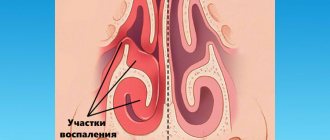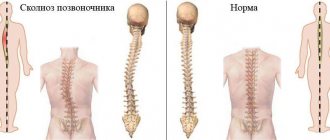Vasomotor rhinitis is an inflammatory process of the nasal mucosa. In a healthy state, the vessels are able to control the volume of air, changing their size due to filling with blood. When bacteria, viruses, microbes, allergens and other foreign bodies enter the body from the outside, the tissue of the shells increases and, as a result, the nasal cavity narrows. In addition, an edematous-secretory reaction is caused by an increase in the excitability of the peripheral parts of the autonomic nervous system (ANS).
Vasomotor rhinitis occurs in people of all ages. It affects more than 10% of residents of megacities. A third of patients experience severe signs of the disease at regular intervals. The average age of patients is 35-45 years. According to statistics, women are twice as likely as men to suffer from vasomotor rhinitis. Treatment should begin after diagnosis. Due to the fact that the disease develops slowly, there is usually no rush to eliminate its symptoms. As a result, it begins to progress and complications appear.
- Patient examination
- Drug therapy
Forms of the disease
Vasomotor rhinitis is of two types: allergic and neurovegetative.
Allergic rhinitis
Allergic rhinitis is a disruption in the blood circulation process that occurs under the influence of allergens, as well as other irritating factors.
The moment they enter the body, an allergic reaction begins, which can be specific or nonspecific. The specific reaction has three stages:
- immunological (production of antibodies),
- the emergence of mediators,
- pathophysiological (inflammatory process).
The symptoms of a nonspecific reaction are caused by close contact with the allergen.
The disease can manifest itself in a seasonal or year-round form. In the first case, the violation is short-term in nature and does not require a prompt response. In the second case, the patient needs to identify the type of allergen using tests. Treatment of vasomotor allergic rhinitis involves the use of antihistamines.
Neurovegetative rhinitis
Neurovegetative rhinitis is a disorder that occurs due to improper filling of the nasal cavity with blood.
It usually develops in people with ANS diseases or under the influence of such external factors:
- aggressive resins,
- dust,
- irritating odors.
Seasonality does not play a role in this case. The main symptom is a runny nose, which appears in the first half of the day and goes away in the evening. Symptoms and treatment of vasomotor rhinitis of the neurovegetative form are determined by an otolaryngologist and a neurologist.
How to treat chronic runny nose in adults. Methods and means of treatment
Depending on the causes of the disease, the following treatment methods are used:
- Possible measures are being taken to eliminate the irritating factor.
- A medication is prescribed to help with chronic runny nose.
- For medical indications, surgery is performed (correction of a deviated nasal septum, removal of tumors).
- Physiotherapeutic methods are used.
- Climate therapy is recommended.
The following drugs are currently used:
- Special moisturizing mucous membrane products.
- Medicines to improve trophism of the nasal mucosa.
- Hormonal drugs.
- Salt solutions and products based on sea water, etc.
The best remedy for chronic runny nose is one that is suitable for a specific form of the disease and is adapted to the course of the patient’s illness and the characteristics of his body. Treatment measures must be comprehensive.
Stages of the disease
As vasomotor rhinitis progresses, it goes through three stages of development:
- First stage. Symptoms are not expressed; the nose becomes blocked when there is an unpleasant odor or when there is a change in temperature.
- Second stage. Inflammation of the mucous membrane begins, and the person is bothered by attacks of itching. Possible development of polyps.
- Third stage. The patient loses his sense of smell, nasal discharge begins, and there is a feeling of mucus in the throat. Immunity decreases.
At risk are people who live in places with high levels of climate humidity, who are predisposed to bad habits and exposure to allergens, as well as those who have unstable hormone levels in the body.
In what cases does secretion production increase?
Among the negative factors that provoke increased production of muconasal nasal secretions, two categories can be distinguished: infectious and non-infectious, including:
- allergens;
- hypothermia;
- lacrimation (crying);
- viruses and bacteria (rhinitis);
- chemical irritants.
When pathogenic agents enter the nasal cavity, the production of mucus, which we are accustomed to calling a runny nose, increases significantly. This is how the protective function of the mucous membrane works when exposed to unfavorable factors that significantly exceed its capabilities.
Reasons for appearance
The reasons that contribute to an imbalance in the structure of the inferior turbinate can be physiological, psychological, environmental and pharmacological.
| External factors: | Internal factors: |
|
|
Symptoms of the disease can appear during age-related changes in the body (female, male menopause), bearing a child and breastfeeding. Regular use of medications can also lead to rhinitis:
- antidepressants,
- tranquilizers,
- alpha blockers,
- contraceptives,
- non-steroidal drugs.
In a child, rhinitis may be a consequence of teething. Also, the reason may lie in primary pathologies: tonsillitis, pharyngitis, deviated septum, etc.
Ozena
Ozena is a chronic atrophic fetid runny nose, which differs from a simple atrophic runny nose by deep atrophy of the entire mucous membrane, bone walls of the nasal cavity and nasal turbinates. Ozena is characterized by the secretion of a thick secretion that dries into foul-smelling crusts.
Despite the fact that the disease has been known since ancient times, the etiology and pathogenesis of ozena continue to remain insufficiently understood to this day. It is now recognized that in the pathogenesis of ozena, a significant role is played by hereditary-constitutional characteristics, transmitted by inheritance as a recessive trait, as well as environmental conditions, incl. nutritional and vegetative insufficiency. As a result, a patient with ozena develops various neuroendocrine, neurovegetative and neurotrophic disorders. The central links that form these disorders probably involve the hypothalamic-pituitary department of the central nervous system.
Clinic and symptoms of ozena
The disease usually begins at a young age, women are more often affected. After the onset of menopause, many clinical manifestations of ozena decrease, which is the basis for considering this disease as being associated with dysfunction of the endocrine glands.
Patients with ozena are characterized by severe atrophy of the nasal mucosa and a decrease in the size of the nasal turbinates, especially the lower ones. Sometimes the lower shells atrophy faster than the middle ones, and therefore the latter appear unusually large against the background of the small atrophied lower ones. As a result of atrophy of the mucous membrane and nasal turbinates, the nasal cavity becomes wide. Often during ozena, the entire nasal cavity is filled with crusts. They usually have a yellowish-greenish, brownish or dirty color and are easily removed in the form of casts. At the same time, the outer surface of the crusts is dry, and the lower surface is viscous, thick, and an extremely unpleasant fetid odor emanates from it, which is a mixture of indole, skatole, phenol, hydrogen sulfide and volatile fatty acids. Actually, of all the objective signs of ozena, stench (kakosmiaobjectiva) should be placed in first place, as the constant and most significant objective symptom. However, patients suffering from anosmia do not feel this smell. It is the stench emanating from ozena patients that makes it impossible for them to communicate closely with other people, determines the tragedy of their situation and puts ozena patients in the position of outcasts of society. All this allows us to consider ozena as a disease of social significance.
Atrophic phenomena during ozena affect not only the nasal cavity, but also the paranasal sinuses and underlying respiratory tract. The crusts filling the nasal cavity spread posteriorly into the nasopharynx and pharynx, closing the mouths of the auditory tubes. Unfavorable conditions are created for ventilation of the tympanic cavity, which contributes to its involvement in the inflammatory process. This is the reason for the often observed damage to the hearing aid in patients with ozena.
Treatment of ozena
Treatment of ozena, as well as other degenerative processes of the nose, is one of the most difficult problems of rhinology. In recent years, however, pathogenetically based conservative and surgical treatment methods have appeared, combined with the use of etiotropic drugs that directly affect Klebsiella ozena. However, symptomatic treatment methods aimed at removing fetid crusts and deodorizing the nasal cavity have not lost their importance and continue to remain in the arsenal of modern rhinologists.
Based on the infectious hypothesis of the etiology of ozena, antibiotics active against Klebsiella ozena are used in treatment. However, these treatment methods do not allow obtaining lasting clinical results.
In the treatment of ozena, surgical methods are mainly used. Thus, based on the idea that dystrophic (atrophic) processes in the nasal cavity develop as a result of a violation of the trophic function of the autonomic nervous system, a synthetic implant (polyurethane, ivalon, etc.) is implanted in the area where the diffuse autonomic ganglion of the nasal septum is located. Inserting a graft into the area of the autonomic ganglion aims to have a positive effect on the trophism of the nasal mucosa. The described surgical method allows for clinical recovery (i.e., cessation of drying of foul-smelling crusts and revitalization of the mucous membrane) in 75% of cases.
Also, at the discretion of the doctor, a conservative method can be used, based on the use of cholinomimetics, anticholinesterase drugs, vitamins E and D, long-acting nitrites, stimulants of tissue regeneration, in particular, metacil. This treatment is carried out for 1 month in a hospital setting.
Symptoms and signs
The main symptom of vasomotor rhinitis is persistent breathing difficulties. Nasal congestion occurs spontaneously. This usually happens in the morning and while lying down. Breathing disorders are accompanied by sneezing, lacrimation, and the release of clear mucus from the mouth. If the disease is accompanied by a bacterial infection, the discharge becomes yellow and green. Body temperature does not increase with vasomotor rhinitis.
The nose may also become stuffy when the patient changes climate or experiences excessive physical activity.
In addition, the clinical picture includes the following main symptoms:
- spasms in the temples,
- redness of the eyeballs,
- heaviness and swelling in the bridge of the nose,
- uncontrolled release of mucus and saliva,
- decreased quality of odor perception,
- redness of the nasal mucosa.
Among the secondary symptoms:
- decreased performance,
- feeling of weakness,
- unstable mental state,
- nervous disorders,
- loss of appetite,
- bitterness in the mouth,
- decreased immunity,
- dyspnea,
- excessive sweating.
Uncontrolled use of drops for vasomotor rhinitis can cause unexpected attacks of itching in the nose. Insufficient ventilation of the lungs entails a disruption of the blood flow process and, as a result, a deterioration in the body’s oxygen supply. This leads to functional disorders of the ANS.
Possible complications and consequences of the disease
Neglect of treatment leads to the following negative consequences:
- chronic oxygen starvation of the body;
- persistent headaches;
- surges in blood pressure;
- noise in the head;
- impaired coordination of movements;
- apnea (stopping breathing);
- persistent impairment of ventilation in the nasal sinuses;
- sinusitis or tonsillitis in chronic form;
- allergic rhinitis;
- rhinitis of non-allergic origin and eosinophilic syndrome;
- occupational rhinitis with loss of ability to work, including disability.
Diagnostics
Before starting treatment for vasomotor rhinitis, the disease should be diagnosed.
| The criteria that the doctor uses when interviewing: | Characteristic signs of the patient's condition: |
|
|
The doctor evaluates the medical history to determine the cause and history of rhinitis. At this stage, the presence of other diseases of the nasal cavity should be excluded.
Patient examination
Determining the clinical picture involves an objective examination of the patient. Before determining how to treat chronic vasomotor rhinitis, the otolaryngologist must determine whether:
- difficulty contracting the walls during breathing;
- an increase in the size of the walls of the nasal cavity;
- mucous or watery discharge;
- disturbance of a person’s well-being (weakness, fatigue).
If necessary, an allergist and neurologist are involved in making a diagnosis. At this stage, symptoms of VSD are revealed:
- lowering blood pressure,
- feeling of coldness in the extremities,
- joint and muscle pain,
- high sweating,
- anxious state.
After this, laboratory and clinical research methods are carried out.
Rhinoscopy
Rhinoscopy is an examination of the nasal cavity using auxiliary instruments: a funnel for children and a mirror for adults. In modern conditions, the procedure is carried out using a video camera. The result is displayed on the monitor, which makes it possible to analyze the disease over time.
During anterior rhinoscopy, a mirror is inserted into the hole to a depth of one to two centimeters, after which it opens in the anterior sections of the sinus. This allows you to evaluate the condition of the anterior part of the septum, as well as the overall nasal passage.
Average rhinoscopy involves inserting a speculum below the middle concha. The doctor can see the middle meatus.
During posterior rhinoscopy, the fiberscope is inserted through the oral cavity to the pharynx. This way you can assess the condition of the back of the shell. To prevent the gag reflex, treatment with an anesthetic occurs. Based on the results of rhinoscopy, it is determined how to treat vasomotor rhinitis without surgery.
Laboratory research methods
To know how to cure vasomotor rhinitis, you need to conduct laboratory diagnostics:
- A general and biochemical blood test allows you to see the number of eosinophils.
- Allergy tests:
- skin allergy tests - when the pathogen comes into contact with the skin, an allergic reaction occurs;
- assessment of immunoglobulin G to the pathogen involves a laboratory analysis of blood serum using a special tablet.
- An immunogram allows you to assess the quality of the immune system.
- Culture analysis of nasal discharge excludes the presence of an additional infection (rhinitis, sinusitis).
- An x-ray shows a change in the color of the maxillary sinuses and the presence of polyp formation.
The list of additional diagnostic methods includes an electrocardiogram and an electroencephalogram.
Sources
- Ogra PL, Welliver RC, Riepenhoff-Talty M. Local immune response to viral antigens. Human immunity to viruses. - New York: Academic Press, 1983. - R. 81-99;
- 21st Congress of European Rhinologic Society (ERS) and 25th International Symposium on Infection and Allergy of the Nose (ISIAN). - Tampere, Finland, 2006, June 11-15;
- Karpova E.P. Rhinitis in childhood // Attending physician. - 2010. - No. 1;
- Volosovets A.P., Krivopustov S.P., Molochek A.I., Po-pivchak P.M. The value of 0.65% sodium chloride solution in the prevention and treatment of diseases of the nasal cavity in children // Child’s Health. - 2008. - No. 5(14). - pp. 23-28;
- Igarashi Y, Skoner DP, Doyle WJ et al. Analysis of nasal secretions during experimental rhinovirus upper respiratory infections // J. Allergy Clin. Immunol. - 1993. - No. 5. - P. 722-731.
Runny nose and medications
Treatment
Treatment of both initial and chronic forms of vasomotor rhinitis is not an easy process.
Complex therapy includes:
- taking measures to protect against infection,
- normalization of lifestyle and recreation,
- correction of diet,
- rejection of bad habits,
- drug treatment,
- physiotherapeutic procedures,
- surgical intervention.
The set of measures depends on the form of the disease, the age of the patient, as well as the presence of other disorders in the body. Treatment of vasomotor rhinitis is carried out at home or in a hospital.
Drug therapy
The goal of drug therapy is to eliminate the symptoms of the disease with further relief of the patient’s condition. To do this, the otolaryngologist may prescribe:
- Antihistamines 2 and 3 generations. They eliminate signs of allergies and fight viral pathogens.
- Medicines that constrict blood vessels. Thanks to the reduced size of the vessels, free breathing is restored.
- Preparations based on corticosteroid hormones. They eliminate the inflammatory process and improve the functioning of the immune system.
Additionally, M-cholinergic receptor blockers and cell membrane stabilizers are prescribed. We recommend asking your doctor what drops you can use for vasomotor rhinitis.
Be sure to rinse the nasal cavity with a solution of sea salt. Make sure that the solution temperature is between 35-40 °C. It is better to prepare it before direct use. The procedure is carried out daily for 10 days.
Vasomotor rhinitis can be treated at home. Its duration is determined individually. The doctor determines it based on the characteristics of the disease.
Drugs for vasomotor rhinitis
Treatment of vasomotor rhinitis with drugs gives stable and long-lasting results. Medicines such as Sialor Rhino and Sialor Aqua are very popular due to their undeniable advantages over other medications.
"Sialor Rhino"
"Sialor Rhino" are nasal drops that have a vasoconstrictor effect. Indications for their use:
- vasomotor rhinitis,
- acute respiratory diseases,
- restoration of drainage function during inflammation.
The drug is prescribed to children and adults.
Among the advantages of the drug "Sialor Rhino":
- convenient way to use,
- instant effect (within a few minutes),
- Possibility of twice daily use,
- the presence of three dosage variations,
- no risk of cross-contamination (contamination during production),
- hermetic packaging (polymer containers).
The basis of Sialor Rhino is oxymetazoline, an alpha-adrenergic stimulant for local use. The product reduces the degree of swelling of the sinus mucosa, clears the airways, and also alleviates the patient’s condition. Its action begins after five minutes and lasts up to 12 hours.
"Sialor Aqua"
"Sialor Aqua" is an isotonic solution for intranasal use. It is based on purified sea water, which not only helps maintain nasal hygiene, but also fights the signs of vasomotor allergic rhinitis.
Among the features of “Sialor Aqua”:
- salt composition,
- safe effect on the body,
- can be used at any age (even for children under one year old),
- convenient and economical form of release (plastic ampoules).
The drug maintains the normal microflora of the mucous membrane, promotes the saturation of mucus with goblet cells, and has an anti-inflammatory and antibacterial effect. Regular use of the solution allows you to stabilize regenerative processes, and also increases the level of activity of the epithelium to external stimuli.
Medicines for vasomotor rhinitis must be taken as prescribed by a doctor. Self-medication can be fraught with unpleasant consequences.
Physiotherapy
Physiotherapy will help get rid of vasomotor rhinitis. How and for how long to carry it out should be discussed with a specialist.
Physiotherapy includes:
- Laser treatment. The light stream is directed to the affected area of the nose, having a beneficial effect on the vascular system.
- UHF therapy. The procedure is carried out using high frequencies. Allows you to reduce swelling and stabilize blood flow.
- Ultrasound irradiation. Facilitates the general condition of the patient. Relevant during severe runny nose and swelling.
Regular physiotherapeutic procedures (once every six months) will reduce the likelihood of developing the disease in the future.
Surgical intervention
If conservative therapy is unsuccessful, vasomotor rhinitis is treated with surgery. This is a last resort measure, which should be resorted to when absolutely necessary. Patients in remission are admitted to it.
Indications for surgical intervention:
- hyperplasia,
- polyposis process,
- deviated septum,
- the presence of pus and ridges.
There are several methods of surgical treatment. The most popular of them is considered to be vasotomy - the process of destruction of the connecting vessels of the periosteum and mucous membrane, due to which they decrease in size. The operation is performed using radiosurgical devices; less often, doctors use a scalpel. If it is necessary to straighten the nasal septum, septoplasty is used.
Electroplasma coagulation allows you to achieve the effect using a coagulator, ultrasonic disintegration - thanks to ultrasound.
One way or another, each of these methods is aimed at destroying tissue to reduce inflammation in vasomotor rhinitis. Nasal spray and other medications during the postoperative period are prescribed on an individual basis.
Symptoms of chronic rhinitis
Chronic rhinitis is accompanied by prolonged difficulty in nasal breathing. There is also a deterioration in the sense of smell, nasal discharge, the formation of mucus flowing down the back wall of the throat, and cough.
Vasomotor rhinitis is accompanied by episodes of sneezing with the release of copious liquid discharge and difficulty breathing through the nose.
With allergic rhinitis, itching and burning in the nose and eyes, severe runny nose, swelling, and sneezing appear.
In severe cases, the nasal mucosa becomes crusty and there is an unpleasant odor when breathing. Atrophic rhinitis is accompanied by dryness in the nasal cavity and pharynx, and nosebleeds.
Often, a patient with chronic rhinitis becomes dependent on decongestants - nasal drops and sprays that temporarily restore normal nasal breathing.
Disease prevention
In order not to wonder in the future about how to cure chronic vasomotor rhinitis, you need to take care of measures to prevent it. To do this you need:
- monitor blood pressure levels;
- do not use harmful chemicals and cosmetics;
- eliminate anomalies in the structure of the nasal cavity;
- eliminate airway obstruction;
- review your diet in favor of healthy foods;
- enrich your menu with minerals, vitamins A and E;
- give up bad habits (alcohol, smoking, drugs);
- stabilize the psycho-emotional state;
- engage in moderate physical therapy;
- avoid infection with viral respiratory diseases;
- normalize the functioning of the immune system.
Regular medical examination helps prevent the development of allergic vasomotor rhinitis. Treatment of symptoms must be agreed with a specialist.
Vasomotor rhinitis (“false rhinitis”)
A characteristic feature of vasomotor rhinitis is the manifestation of a runny nose symptom complex without pathological signs of inflammation of the mucous membrane. This is either a neurovegetative runny nose, which is a manifestation of autonomic neurosis, or an allergic one, which occurs in response to the action of allergens.
The basis of the neurovegetative form of vasomotor rhinitis is the inadequate “play” of the vessels that make up the main content of the cavernous bodies of the turbinates. These are cycles characterized by regular narrowing and expansion of the vessels of the nasal concha. Subjectively, no nasal breathing disturbances are felt. This alternating cyclical fluctuation of nasal congestion can be considered as a normal manifestation of physiological functional asymmetry. On the other hand, a more pronounced enlargement of the nasal turbinates, in which a clearly felt difficulty in nasal breathing appears, is a pathological condition, namely vasomotor rhinitis, in particular its neurovegetative form.
In healthy individuals, a change in the predominance of breathing through one or another half of the nose occurs according to a sinusoidal law with a period of 20 to 90 minutes, and the ratio of the volumes of exhaled air varies from 25% to 75%, i.e. complete congestion of one half of the nose is not observed. In patients with the neurocirculatory form of vasomotor rhinitis, there is a violation of the period and linearity of the law of change in the predominance of nasal breathing. Their exhaled air volume ratio ranges from 0% to 100%.
In the occurrence of the neurovegetative form of vasomotor rhinitis, the main role is played by functional changes in the central and autonomic nervous systems, as well as the endocrine system. The hypothalamus, the main integrating autonomic center in the regulation of nasal functions, plays an important role. The influence of dysfunction of the endocrine glands, primarily the thyroid gland, on the development of vasomotor rhinitis is also important. Vasomotor rhinitis is an endocrine-vegetative syndrome.
The development of vasomotor rhinitis is also facilitated by reflex effects, in particular: cooling, to which non-hardened people are especially susceptible; sedentary lifestyle; medications used for hypertension and coronary heart disease to dilate blood vessels, etc. Vasomotor rhinitis often occurs in people who have spines and ridges on the nasal septum.
Allergic form
The allergic form of vasomotor rhinitis occurs when exposed to various allergens, and depending on their name, seasonal and permanent (year-round) forms of allergic rhinitis are distinguished. Allergic rhinitis is one of the most common diseases. According to various studies, they occur in 10 - 40% of the population.
The cause of the seasonal form of allergic rhinitis (hay fever) can be pollen from various plants during their flowering period. Residents of many cities are especially concerned about the fluff and pollen of poplars, while rural residents are concerned about the cereals blooming in the fields (timothy, fescue, etc.). In recent years, ragweed, an overseas cereal that has penetrated into the southern regions of Russia from North America and has increased allergenic properties, has become relevant.
In the permanent (year-round) form of allergic rhinitis, the allergens are more diverse and can affect patients over a long period. These include: environmental allergens - book dust, relevant for library workers; house dust, bird feathers (feather pillows), hair, pet dander, daphnia (dry food for fish living in an aquarium); food products - citrus fruits, strawberries, honey, milk, fish, crayfish; medicines, perfumes, etc.
The pathogenesis of allergic rhinitis involves a specific reaction between the allergen and tissue antibodies, resulting in the release of chemically active substances (allergic reaction mediators) that contribute to the development of clinical manifestations of the disease. The possible mechanism of development of allergic rhinitis is described as follows.
An Ig E-dependent reaction occurs - activation of mast cells located in the nasal mucosa. The released mediators are contained in granules (for example, histamine and tryptase) or in the membrane of mast cells (leukotrienes and prostaglandins). Another mediator is platelet activating factor (PAF). Mediators have a vasodilating effect and increase vascular permeability, which leads to nasal congestion. Increased secretion is accompanied by the appearance of mucous discharge. Stimulation of afferent nerve fibers causes itching and sneezing. In addition, afferent stimulation (especially under the influence of histamine) can enhance the axonal reflex with local release of neuropeptides (substance P, tachykinins), which, in turn, cause further degranulation of mast cells, further enhancing the pathological response.
Neurovegetative form
In the neurovegetative form of vasomotor rhinitis, no specific changes in the mucous membrane are observed. The ciliated epithelium is thickened, the number of goblet cells is increased. The cavernous vessels are dilated. Microcirculation is disrupted. These disturbances are especially noticeable in the inferior turbinates. The movement of blood in the capillaries is uneven and often does not correspond to pulse impulses. In the allergic form of vasomotor rhinitis, stasis occurs. The epithelial cover of the mucous membrane thickens, in places metaplasizing into a multilayered flat layer. The number of goblet cells increases significantly. In the subepithelial layer, tissue infiltration with eosinophilic leukocytes takes place. They are also found in significant quantities in nasal mucus.
Clinic of the neurovegetative form of vasomotor rhinitis
As with all forms of vasomotor rhinitis, the neurovegetative form is characterized by the following symptoms: difficulty in nasal breathing, profuse serous or mucous discharge, attacks of paroxysmal sneezing, itching and burning sensation in the nasal cavity. These symptoms are often intermittent. They can occur after waking up from sleep (a change in the predominance of the parasympathetic over the sympathetic autonomic nervous system), with a change in ambient temperature, with overwork, emotions, stress, etc. Difficulty in nasal breathing is associated with the expansion of the cavernous spaces of the nasal mucosa, mainly the lower nasal shells The mucous membrane has a bluish color due to blood overflow (venous hyperemia). "Bluish or pale" spots are often visible. Lubricating the mucous membrane with vasoconstrictor drugs leads to rapid contraction of the conchae.
Clinic for seasonal allergic rhinitis (hay fever)
This form of vasomotor rhinitis is characterized by a clear seasonality of exacerbation, which occurs during the flowering period of plants to the pollen of which patients have increased sensitivity (sensitization). During this period, paroxysms of sneezing, itching and burning in the nasal cavity, eyes, and conjunctival hyperemia are noted. Almost complete nasal congestion and severe rhinorrhea occur, which leads to maceration of the skin in the vestibule of the nose. The mucous membrane in the initial period is sharply hyperemic, and there is a significant amount of clear fluid in the nose. Subsequently, the mucous membrane acquires a cyanotic appearance and then turns pale. Along with the noted rhinological symptoms, patients during this period often experience itching in the eyes, conjunctival hyperemia, a feeling of rawness in the pharynx, larynx and skin itching. In some cases, it is possible to develop Quincke's edema (enlargement of the face or part or limb) and larynx. Various discomfort manifestations are observed, incl. headache, increased fatigue, sleep disturbance, increased body temperature. The duration of the disease usually corresponds to the period of flowering of plants and ceases on its own after its end or after the patient changes the allergenic area.
An intermediate position between the neurovegetative form of vasomotor rhinitis and seasonal allergic rhinitis is occupied by the so-called. "neurosis of a reflected nature." Thus, in people suffering from hay fever, which occurs when smelling flowers, in particular roses, attacks of a runny nose are observed not only when inhaling the aroma of flowers, but also when just looking at an artificial rose, which the patient mistakes for a real one. In these cases, there is a combination of conditioned reflexes coming from the optic and olfactory nerves.
Clinic for permanent (year-round) form of allergic rhinitis
The disease is chronic from the very beginning. Severe swelling of the nasal turbinates is detected, associated with profuse sweating of transudate from the capillaries. The mucous membrane is pale; swelling affects not only the turbinates, but also the mucous membrane of the bottom of the nasal cavity and the nasal septum. The middle turbinates are also swollen, resembling polyps. Due to swelling of the mucous membrane, mucus is difficult to clear and can be discharged from the nose at random.
The allergic form of vasomotor rhinitis is characterized by the formation of mucous polyps. Gradually increasing in size and quantity, they can fill the entire nasal cavity, in some cases pushing apart the bone walls and deforming the external nose. Often there is a combination of allergic rhinitis with bronchopulmonary pathology - asthmatic bronchitis and bronchial asthma. An “asthmatic triad” may occur, including intolerance to acetylsalicylic acid, nasal polyposis and attacks of bronchial asthma.
Treatment of the neurovegetative form of vasomotor rhinitis
It consists of eliminating various causes, often of a reflex nature, that cause this disease. It is necessary to treat general diseases (neuroses, diseases of internal organs, endocrine dysfunction). If there are any local abnormalities in the nasal cavity (Conchabullosa, spines and ridges of the nasal septum), they should be eliminated. An active, mobile lifestyle and hardening procedures are recommended, in particular, effects on reflex zones - short-term dousing of cold water on the soles of the feet. Performing various gymnastic exercises.
Systematic use of vasoconstrictors is not recommended, because this gives only a short-term effect, and with prolonged use it damages the mucous membrane and is addictive. Acupuncture is also used, influencing the reflex zones of the nasal cavity (novocaine blockades in the inferior nasal turbinates, in the aggernasi, on the sphenopalatine node). Surgical interventions on the inferior turbinates (various options for intraturbinate disintegration) are more effective.
Treatment of allergic rhinitis
There are three main areas in the treatment of allergic rhinitis: elimination therapy, immunotherapy and drug therapy. The goal of elimination therapy is to eliminate allergens (pollen, dust, etc.) and control the state of the environment. Specific immunotherapy is very effective, but severe reactions are possible, especially in people suffering from bronchial asthma. It is not widespread in our country. In other countries (Great Britain, Scandinavian countries), the use of specific immunotherapy is sharply limited. To minimize the risk of immunotherapy, the question of its appropriateness should be decided by an allergist or clinical immunologist. Currently, drug therapy for allergic rhinitis has acquired the greatest importance.
Our medical center successfully treats various types of chronic rhinitis!
Cost of ENT services in our Medical Center
Rating 4.09 (11 Votes)









